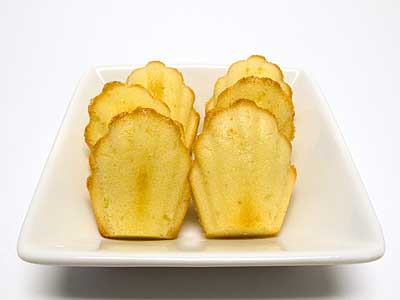June 6, 2011
Mignardise

petits madeleines
(Madeleines)
“And suddenly the memory returns. The taste was that of the little crumb of madeleine…” With that one little involuntary memory of a time forgotten, Proust forever associated himself with these traditional, French sponge cakes. Or so I’ve been told. Because for me, when I hear the name Madeleine, what comes to mind is Ludwig Bemelmans’s 1939 children’s story Madeline. I seemed to have had the story on a record as well as the book when I was small because I also always associate the memory with Schubert’s Rosamunde, which must have been used for the background music on the record. (But I don’t think Schubert’s title character went to the hospital to have her appendix removed.)
On the few occasions that I ate madeleines, I was not impressed. They just seemed like dry sponge cake. (I didn’t know that you were supposed to dip them in your coffee or tea.) That was until I had a petite madeleine as part of the mignardise plate at Roland Passot’s La Folie Restaurant in San Francisco. These small, one-bite cakes were moist and delightful. They also had a small cherry or other fruit inside to add moisture and sweetness. Later, when I had the opportunity to stage in the restaurant, I got to prepare many plaques of these little cakes, and develop a new appreciation for them.
When I decided to make Madeleines for my mignardise plate, I looked at a number of recipes and eventually settled on one in The French Cookie Book by Bruce Healy with Paul Bugat. Since all the recipes were for making standard-sized madeleines and not the small ones I wanted, I needed a recipe that looked like it could downsized and still work. The following quantities still yield about 48 small madeleines, but luckily, they freeze well. They are still best an hour out of the oven because the crunchiness around the edges is somewhat fleeting, but most of that makes it through the freezing if packaged properly.
I tend to make plain madeleines, but on occasion have also added a little fruit to them. After the batter is piped, I’ll drop something like a small blueberry into the center of the batter. If I use fruit, I serve the madeleines the same day.
One trick I learned in France, when working with batters like this, is to use a disposable plastic pastry bag, and after removing as much air as possible from the bag, heat seal the open end. This way you can make the batter in advance and bake the cookies shortly before serving. The sealed pastry bag is leak-proof and makes it easy to fill the cavities on the plaque. Be careful not to overfill the cavities. Madeleines are little cakes, and they rise and spread like cake batter with it’s baked. Under filling is better than over filling.
75 g (5 T)
unsalted butter, softened
75 g (5 T)
finely granulated sugar
2 large
eggs
68 g (8-2⁄3 T)
cake flour
1⁄4 t
baking powder
scant 1 t
vanilla extract
1. Place the butter in a bowl and beat with a wooden spatula until smooth, white, and creamy.
2. In a separate bowl whisk the sugar and eggs until pale yellow and lightly thickened, about 2 minutes. Fold in the flour and baking powder. Mix in the vanilla extract. Add some of the batter to the butter and mix thoroughly. Fold in the remaining batter. Set aside to rest for 30 minutes.
3. Preheat oven to 245 °C (475 °F). Set a silicone mini-Madelines plaque on a baking sheet and set aside.
4. Transfer the batter to a pastry bag. Pipe small mounds of batter into the wells of the plaque. Bake on a lower rack until starting to brown around the edges, about 8 minutes.
5. Cool on a rack and eat the same afternoon or freeze.
© 2011 Peter Hertzmann. All rights reserved.
